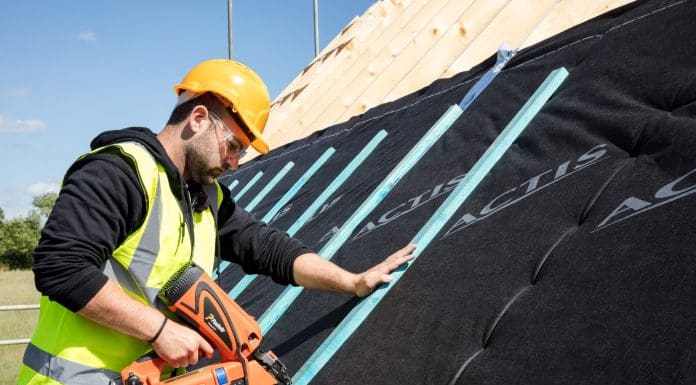As the UK recovers from the impact of Storms Bert and Darragh, Actis urges roofing professionals to use compliant materials- such as Actis’ breather membrane range
Storms Bert and Darragh serve as a reminder of the importance of constructing roofs which can withstand extreme weather conditions, says insulation specialist Actis, whose insulating breather membrane Boost R Hybrid Roof is BRE-approved for use in even the windiest parts of the UK.
Roofing professionals, who must comply with building standard BS5534:2014 slating and tiling for pitched roofs and vertical cladding code of practice specifying criteria, will be reassured by the fact that the membrane has passed the BRE’s all-important wind uplift resistance test – making it an obvious choice for use anywhere in Britain and Northern Ireland.
The building standard addresses every component of the construction of a standard roof
As well as underlays, it covers mortar bedding, battens, flashings and structural sheathing fixings.
The BRE wind uplift resistance labelling ensures that roofers and builders can easily identify the correct underlay for the geographical region in which they are working. This is particularly relevant for contractors in Scotland, the North of England and ultra-windy parts of the UK.
The test, carried out when the revised standard came into force a few years ago in the face of increasingly extreme weather incidents, concluded that Actis Boost ‘R Hybrid Roof and Boost R Hybrid are suitable for use across all five regions, or zones, of the UK identified under the new system, from the most northerly islands of Scotland to the most southerly point of England.
It’s worth noting that not all underlays can cope with the windier conditions of Scotland or the far North of England, with some only suitable for use in zones one to three.
Using Boost R Hybrid Roof means builders can minimise the ‘ballooning effect’ which sees the underlay force tiles and slates off the roof in high winds. Underlay is not allowed to balloon more than 35mm.
The wind uplift pressure achieved by Boost ‘R Hybrid Roof during the tests was way more effective than that required under the building standard, which calls for a minimum wind uplift resistance of 1600 Pa for a 345mm batten gauged roof covering, rising to 2350Pa for roofs with no ceiling and a permanent dominant opening.
Boost R Hybrid Roof managed an impressive average of 3054Pa when used with taped lap alone and 5748Pa with the addition of a 38mm counter batten.
*The map shows the zones in which Boost R Hybrid can be used. It has been approved for use in zones 1- 5 while some underlays only achieve zones 1 – 3 approval. © IHS, reproduced with permission from BRE DG 489, 2014 edition
The post Storms Bert and Darragh underline importance of constructing wind-proof roofs, says Actis appeared first on Planning, Building & Construction Today.


